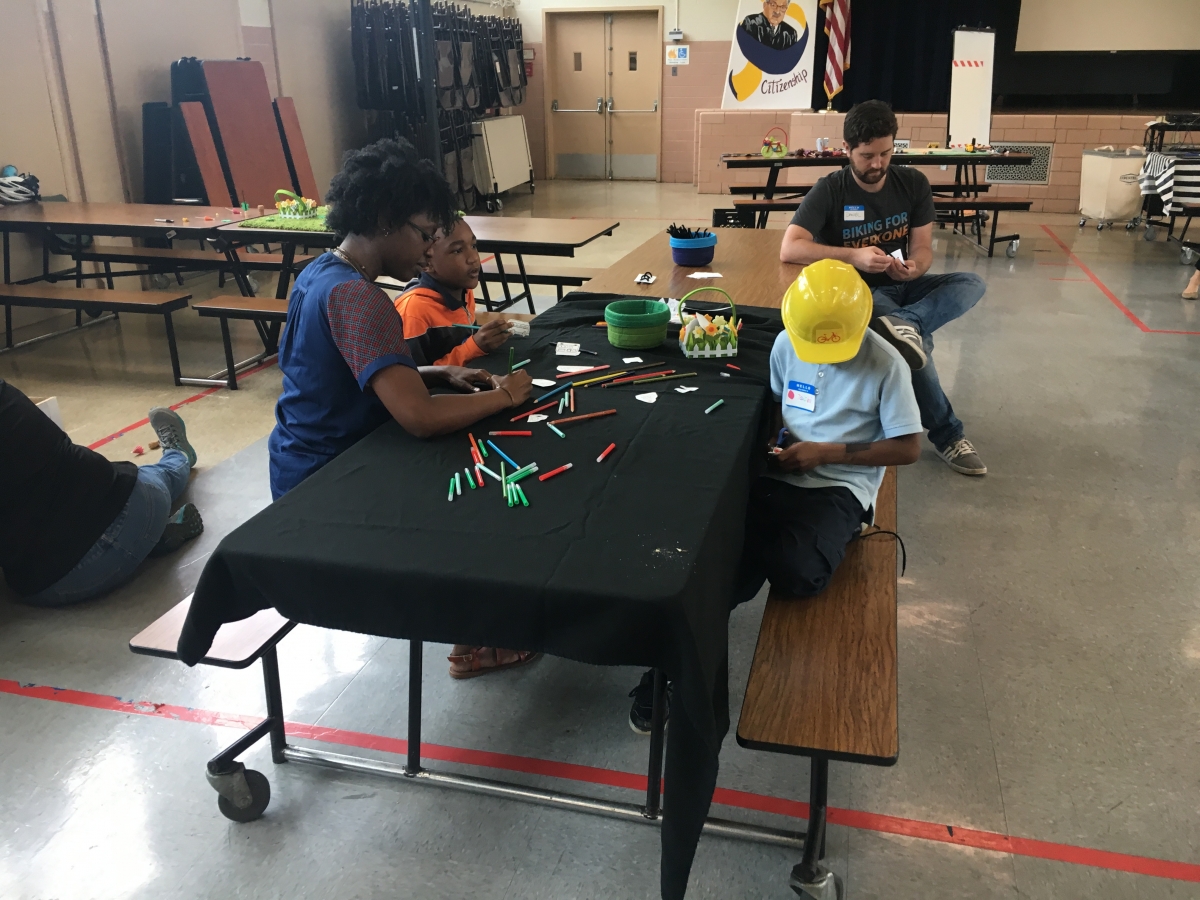This guest blog post was written by Tiffany Lam, research adviser.
Some schools are experimenting with traffic gardens like the one pictured above. Photo: Fionnuala Quinn/Bureau of Good Roads
Now that it’s September and school is back in swing, it’s a great time of year to think about creative and innovative ways to get more kids walking and biking to school. Bicycle education in schools is one effective way to help encourage more physical activity, develop healthy habits, and prevent or reduce the risk of chronic disease and obesity early on. In Denmark and the Netherlands, traffic gardens (or playgrounds) have been a key piece of bicycle education for children since the 1950s. Traffic gardens vary in size and form, but typically are miniature, child-scale traffic towns that provide a safe space for children to improve their bicycling skills and learn how to safely share road space with other users. For example, a traffic garden may have small roads winding around green space and trees, traffic signals, road markings, sidewalks, crosswalks, bike paths, bus stops, and driveways to simulate the experience of navigating on actual roads.
Now, some schools in Washington, DC, have been experimenting with traffic gardens as a way to engage children in transportation, street design, and road safety issues. The schools enlisted the help of the Bureau of Good Roads, a company that teaches people about street design and transportation. Following observations and discussions about how streets are designed, the children made a design plan for a traffic garden. They tried to create a holistic street network that allows people to get around in different ways—by foot, bicycle, public transit, or car. The Safe Routes to School National Partership is currently working with the Bureau of Good Roads to bring traffic gardens to two more schools in Washington, DC.

Safe Routes Partnership's DC Community Engagement Manager Kori Johnson works with second grade students to conceptualize their traffic garden. Photo: Fionnuala Quinn/Bureau of Good Roads
The children’s traffic garden design prototype included some pretty standard street fixtures, like pedestrian crossings, roundabouts, and traffic lights, as well as some more innovative features, like a tricycle share system, self-driving car, and a designated self-driving car parking spot. The next step was to actually build the traffic garden, using cardboard boxes, fabric, duct tape, and other recyclables and arts & crafts supplies. When construction was completed, the children commemoratively cut the ribbon and proudly presented their work to parents, staff, and street design practitioners, complete with lessons on how to use the tricycle share system and self-driving car demonstrations. Overall, the children were bubbling with enthusiasm as they shared what they had learned about safety for walking and bicycling, safe street design, and transportation planning.
The beauty of using traffic gardens as an educational tool is that it offers an immersive, experiential learning opportunity. It goes beyond safety do’s and don’t’s and engages children in a holistic and hands-on way about how to make streets safer and more comfortable for different kinds of road users. It teaches children how the built environment helps facilitate different transportation choices, and how better design and engineering can enable healthier, safer, and more sustainable modes of transportation, like walking and bicycling. Moreover, using traffic gardens as a teaching tool makes tangible the role of engineering in our day-to-day lives. Piquing girls’ interest in engineering early on could plant a seed to inspire them to later pursue it, which would increase diversity in engineering.
We can’t always import European solutions as a magic bullet, but traffic gardens are an interesting idea that Safe Routes to School practitioners could adopt to bring more attention to children’s school commutes. Research shows that transportation planning is often based on the journey to work, which leaves out children’s journeys, like their school commutes. But Safe Routes to School for children and adolescents are important, especially given the health benefits as well as the link between physical activity and improved academic performance and cognition. Traffic gardens could not only help equip children with the skills to safely navigate streets when walking or biking, but also provide them a better understanding of the behind-the-scenes of street design and transportation planning. Planting this seed early on could lead to healthier, more active communities as well as safer streets for all to enjoy.
Want to learn more about traffic gardens? Check out another blog post on the topic.
This guest blog post was written by Tiffany Lam, research adviser.


